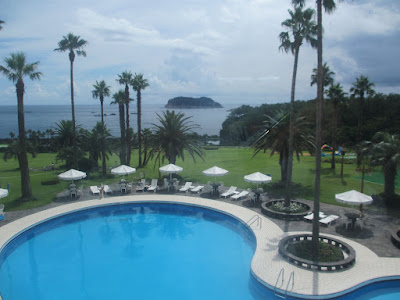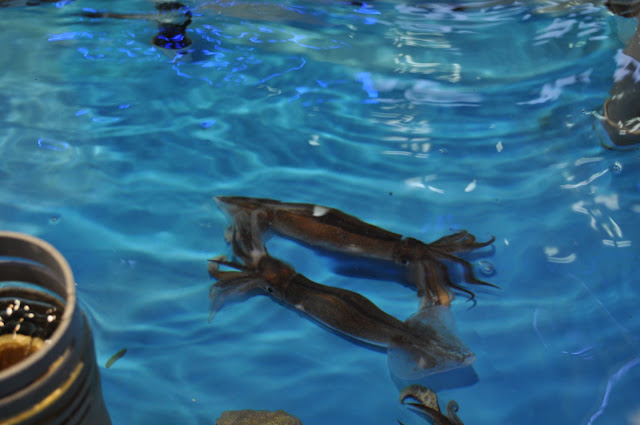Long time without blogging! Before I went to Europe in July I wanted to write many posts, but immediately after I arrived I was initially captured by family and friends, and immediately after from the organization of a conference, actually the first large international
conference on geodynamics in Korea. It was an honor to have an important role in this event, and in this country, but it was also first of all a lot of work. At the end I was so tired that for two weeks I could not do almost anything.
Jeju is a famous island in the South of the country, known for 30 years for being a love paradise for couples, but now mainly a touristic attraction for everybody. One of the great things of the event was that finally many friends who had never the chance to see Korea came to visit me. The first was Manuele Faccenda, who arrived from Padova one week before the meeting. In this photo he had just tried some hyper-spicy octopus! He survived, which is a pretty positive outcome for a newcomer.
I have have a lot of photos from the meeting, but they would be quite boring for most of you. I will show only a few of them. This was the view from the hotel. Not bad, really!
A great thing of the hotel is that they had a little band formed by a guy playing a guitar and a singer. The girl was a blonde korean (well, not a real blonde, I guess), which is kind of special, and she had a great voice, but she was also unbelievably shy. Every time we tried to go to talk to her or just say "hurray", "great", she would freak out and leave. That happened every night, and it was difficult to understand for us. I just guess that this hotel is normally a romantic place, for just married couples, and the girl rarely received such an enthusiastic and loud response.

The conference room was beautiful with a great view on the sea. I cannot say anything about the conference, as I composed the program, so I cannot be fair. I know what worked well and what not. It was the first time that I had so much to do, and organize everything with so many prominent scientists. I had also to overcome my usual shyness. Half of the participants came from US, Europe and Australia, therefore the logistic was quite complex. I have spent most of the time running here and there, organising little things like finding a timer for the talks, deciding where to hang the posters, announcing changes of schedule, where to meet, when to eat, and so on. The nicest part of the conference was the discussion, in which we tried to address some of the main problems related to the last earthquake in Tohoku. I think that this will occupy a substantial portion of my future work. We had the goal of bridging several disciplines, from the tsunamigenic earthquakes to numerical models. From this point of view, I think that we did a good work.

Here on photo on the top you can see the back Scott King looking at the tsunami propagation slides . On the bottom left me and Sang-Mook Lee chatting and on the right image I show the room with some participants. Yes, I don't know how, but many can follow the talks while reading their emails. It is interesting how many seem distracted, but in fact they carefully listen (well, I hope so, at least!).
And fortunately we did not only work, but we had some really good time in the hotel garden, also with the new t-shirts promoting the secret "Geodynamics Liberation Front" created by the team of the Scripps (thanks Dave Stegman and Robert Petersen!).
With the contribution of few biers and some (very expensive) wine, the nights turned to be very pleasant. Here we have some members of the international community. Form the left to right, you can see Erik Sevre (Seoul), Fabio Capitanio (Melbourne), Dave Yuen (a myth of geophysics, from Minneapolis) and Sylvain Barbot, now in Singapore. On the right foto the famous Paul Tackley (Zurich), also my former boss for some time, Dave Stegman (San Diego) and Erik again. On the first night we also managed to jump in the pool (absolutely forbidden after 7pm) but on the second day the ones who tried have been discovered, which created some little problem with the hotel management...
The hotel and the pool.
The last day of the meeting, after 10 hours of talks and discussions every day, we were destroyed and we went finally to explore the island. First we headed to the longest lava flow "tunnel" in the world (several kilometers!). On the left there is a piece of lava dropping from the tunnel top. On the other side again Dave Yuen with his chinese friends.
Here I show are curiosities from the "lava" museum in Jeju. The museum is a really a special place, a permanent exhibition of many things that we actually research, here shown to the public. It was strange to see that. They also have nice blocks of basalts, with plumes and planes of bubbles of gas, which is one of my main research topics.
Probably the most original character of Jeju is the periodic eruption, about one every 1000 years, happened in the past 500,000 years, each one in a different location of the island. This makes the products of the lava the most relevant, so it was inevitable that habitants specialized in a variety of statue and other artistic products made of this material. Here some "exotic" examples:
And of course the main product of Jeju: the black pig! I think that few things had so much success as the dinner on the last day... this is Korean style!
Next post: the adventure along the coast of eastern Korea with Manuele and Fabio!



















































































